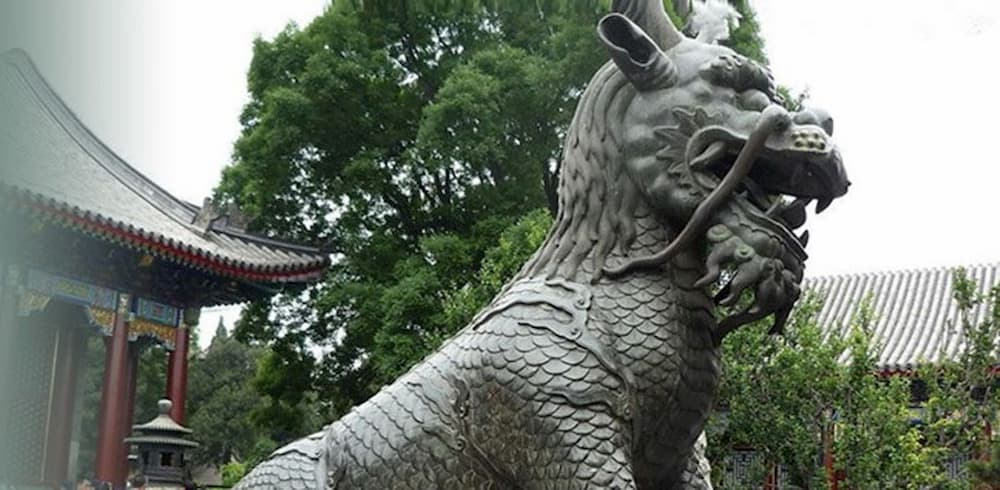
Auspicious Figures
Splendid
Chi Culture
Topic
Auspicious Figures
Auspicious figures often reflect characteristics of the groups who adopt them. As life is about survival, it is human nature to see some things as omens and others as auspicious signs. This is understandable when one considers ancient humans often faced sudden disasters or suffered in harsh circumstances. They did their upmost to pursue a safe and happy life. What kind of life could be considered happy? Most people considered a life graced with the “five blessings” to be a happy life.
Auspicious figures, used to express a desire for a good life, are deliberately created from the attributes and characteristics of the figure itself. The development involves transforming inherent properties into symbols of good fortune by relying on homophones, myths, legends, and the artisan’s craftsmanship. We can learn about these people, their lifestyles and what they cherished from these auspicious symbols.
Auspicious figures fall into four major categories: longevity, wealth, long family lines, and joyous occasions. Traditional Chinese culture emphasizes happiness, longevity, well-being and tranquility. Longevity is particularly important. The ancients believed that the destiny of a person’s life was bestowed by heaven and cannot be undone by humans. The Bei shi (History of the Northern Dynasties) says: “Among all precious things that humans treasure, nothing is more precious than life.” In ancient times, humans often fought against the natural environment for their own survival, and the auspicious figures (they selected) often had something to do with “longevity”—deer (the word in Chinese is a homophone of “high-ranking official”), cranes, pine trees, peaches, zithers (representing harmony), and longevity stones (pagodite or agalmatolite).
“Wealth” in the eyes of the Chinese refers to the quantity of private property. In fact, the ancients most desired the “five blessings” as indicated in the Shang shu (Classic of documents)—longevity, prosperity, well-being, and tranquility, “the love of virtue” and “to die peacefully after a long life”; or in more modern terms “good fortune,” “emoluments of office,” “happiness,” and “fortune.” Most of the wishes involve the concept of “wealth.” Such auspicious objects include: goldfish, carp, peony, orange, treasure basin (cornucopia), and the civil and military gods of Wealth.
A common Chinese expression is “to have a growing family”; it expresses the aspirations of countless generations of Chinese people, especially among the ancient people who did not have the concept of birth control. The desire to produce and have an heir can be seen everywhere in traditional Chinese customs and culture. For example, the expressions “Child-bestowing Guanyin,” “the guardian spirit of sons,” “Having sons is like adding lights to the house,” “the child-delivering qilin” can be heard and seen everywhere. This indicates that having children and their children having children are common auspicious occasions along with wishes for “blessings, high rank, longevity, happiness, and wealth.” The figures associated with these include rabbits, chickens, lilies, pomegranates, and the written phrases “Guanyin delivers a child,” and the “four-happiness.”
Festivities refer to things worthy of joy and celebration. In traditional Chinese culture, they can be described by the widely-circulated poem “Four Happinesses” by Wang Zhu (who lived during the Northern Song, and in 1100 passed the jinshi exam): “A genial rain after a long drought, / Running into an old friend away from home, / The wedding night in the nuptial chamber with candle light, / One’s name on the list of successful candidates who sat the civil examination.” Symbols associated with joy and celebration include: magpies, bats, gourds, bamboos, money and chickens made from cloth, and ruyi “scepters” (an S-shaped rod symbolizing good fortune).
In addition to the animals mentioned above, the Li ji (Record of rites) names others: “the qilin (or unicorn), the phoenix, the turtle (or tortoise), and the dragon; these are called the four efficacious creatures. When the dragon becomes a domestic animal, (all other) fishes and the sturgeon do not lie hidden from men (in the mud). When the phoenix becomes so, the birds do not fly from them in terror. When the qilin does so, the beasts do not scamper away. When the tortoise does so, the feelings of men take no erroneous course.” The ancients considered the qilin the king of the beasts, the dragon the king of scaled creatures, the tortoise the king of shelled fish, and the phoenix the king of the birds. The ancients believed that the four efficacious creatures control all living creatures in the universe—they not only are friendly to humans, they are also auspicious and festive omens.



